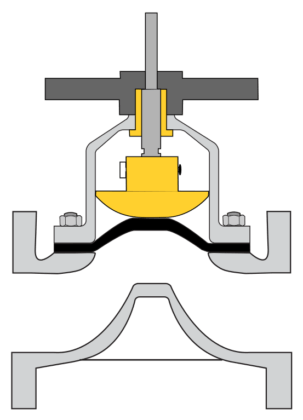Diaphragm valves use a flexible sheet pressed close to the edge of a solid dam to narrow the flow path for fluid.
Their operation is not unlike controlling the flow of water through a flexible hose by pinching the hose. These valves are well suited for flows containing solid particulate matter such as slurries, although precise throttling may be difficult to achieve due to the elasticity of the diaphragm.

Diaphragm valves (or membrane valves) consists of a valve body with two or more ports, a diaphragm, and a “weir or saddle” or seat upon which the diaphragm closes the valve. The valve body may be constructed from plastic, metal, wood or other materials depending on the intended use.
There are two main categories of diaphragm valves: one type seals over a “weir” (saddle) and the other (sometimes called a “full bore or straight-way” valve) seals over a seat. The weir or saddle type is the most common in process applications and the seat-type is more commonly used in slurry applications to reduce blocking issues but exists also as a process valve.
While diaphragm valves usually come in two-port forms (2/2-way diaphragm valve), they can also come with three ports (3/2-way diaphragm valves also called T-valves) and more (so called block-valves). When more than three ports are included, they generally require more than one diaphragm seat; however, special dual actuators can handle more ports with one membrane.
The photograph shows a diaphragm valve actuated by an electric motor, used to control the flow of treated sewage:
The following photograph shows a hand-actuated diaphragm valve, the external shape of the valve body revealing the “dam” structure against which the flexible diaphragm is pressed to create a leak-tight seal when shut:
Some diaphragm valves are pneumatically actuated, using the force of compressed air on one side of the diaphragm to press it against the dam (on the other side) to shut off flow.
This next example is of a small air-actuated diaphragm valve, controlling the flow of water through a 1-inch pipe:
The actuating air for this particular diaphragm valve comes through an electric solenoid valve. The solenoid valve in this photograph has a brass body and a green-painted solenoid coil.
Rotating equipment packages such as pumps, compressors, turbines need the lube oil consoles for their…
This article explains how to blink lights in ladder logic with a detailed explanation video…
In this article, a simple example will teach you the conversion from Boolean algebra to…
In this article, you will learn the PLC cooking timer example for kitchen automation using…
Learn an example PLC program to control a pump based on level sensors using ladder…
In the PLC timer application for security camera recording, when motion is detected then camera…